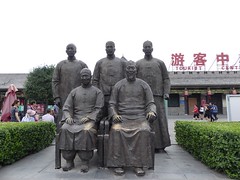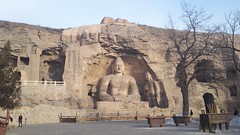Shanxi Sheng
Shanxi (English: /ʃænˈʃ/;; formerly romanised as Shansi) is a landlocked province of the People's Republic of China and is part of the North China region. The capital and largest city of the province is Taiyuan, while its next most populated prefecture-level cities are Changzhi and Datong. Its one-character abbreviation is "" , after the state of Jin that existed there during the Spring and Autumn period.
The name Shanxi means "West of the Mountains", a reference to the province's location west of the Taihang Mountains. Shanxi borders Hebei to the east, Henan to the south, Shaanxi to the west and Inner Mongolia to the north. Shanxi's terrain is characterised by a plateau bounded partly by mountain ranges. Shanxi's culture is largely dominated by the ethnic Han majority, who make up over 99% of its population. Jin Chinese is considered by some linguists to be a distinct language from Mandarin and its geographical range covers most of Shanxi. Both Jin and Mandarin are spoken in Shanxi.
Shanxi is a leading producer of coal in China, possessing roughly a third of China's total coal deposits. Nevertheless, Shanxi's GDP per capita remains below the national average. The province hosts the Taiyuan Satellite Launch Center.
The province is also known for having by far the largest number of historic buildings among all Chinese provinces, by possessing over 70% of China's surviving buildings built during or predating the Song dynasty. Also notable are the Yungang Grottoes, which date back over 1500 years.
History
Pre-Imperial China
In the Spring and Autumn period (722–403 BC), the state of Jin was located in what is now Shanxi Province. It underwent a three-way split into the states of Han, Zhao and Wei in 403 BC, the traditional date taken as the start of the Warring States period (403–221 BC). By 221 BC, all of these states had fallen to the state of Qin, which established the Qin Dynasty (221–206 BC).
Imperial China
The Han Dynasty (206 BC – AD 220) ruled Shanxi as the province of Bingzhou.
During the invasion of northern nomads in the Sixteen Kingdoms period (304–439), several regimes including the Later Zhao, Former Yan, Former Qin, and Later Yan continuously controlled Shanxi. They were followed by Northern Wei (386–534), a Xianbei kingdom, which had one of its earlier capitals at present-day Datong in northern Shanxi, and which went on to rule nearly all of northern China.
The Tang Dynasty (618–907) originated in Taiyuan. During the Tang Dynasty and after, present-day Shanxi was called Hédōng , or "east of the (Yellow) river". Empress Wu Zetian, one of China's only female rulers, was born in Shanxi in 624.
During the first part of the Five Dynasties and Ten Kingdoms period (907–960), Shanxi supplied rulers of three of the Five Dynasties. Among the Ten Kingdoms, it was the only one located in northern China. Shanxi was initially home to the jiedushi (commander) of Hedong, Li Cunxu, who overthrew the first of the Five Dynasties, Later Liang (907–923) to establish the second, Later Tang (923–936). Another jiedushi of Hedong, Shi Jingtang, overthrew Later Tang to establish the third of the Five Dynasties, Later Jin, and yet another jiedushi of Hedong, Liu Zhiyuan, established the fourth of the Five Dynasties (Later Han) after the Khitans destroyed Later Jin, the third. Finally, when the fifth of the Five Dynasties (Later Zhou) emerged, the jiedushi of Hedong at the time, Liu Chong, rebelled and established an independent state called Northern Han, one of the Ten Kingdoms, in what is now northern and central Shanxi.
Shi Jingtang, founder of the Later Jin, the third of the Five Dynasties, ceded a piece of northern China to the Khitans in return for military assistance. This territory, called the Sixteen Prefectures of Yanyun, included a part of northern Shanxi. The ceded territory became a major problem for the Song dynasty's defence against the Khitans for the next 100 years because it lay south of the Great Wall.
The later Zhou, the last dynasty of the Five Dynasties period was founded by Guo Wei, a Han Chinese, who served as the Assistant Military Commissioner at the court of the Later Han which was ruled by Shatuo Turks. He founded his dynasty by launching a military coup against the Turkic Later Han Emperor, however his newly established dynasty was short-lived and was conquered by the Song Dynasty in 960.
In the early years of the Northern Song Dynasty (960–1127), the sixteen ceded prefectures continued to be an area of contention between the Song dynasty and the Liao dynasty. Later the Southern Song Dynasty abandoned all of North China, including Shanxi, to the Jurchen Jin dynasty (1115–1234) in 1127 after the Jingkang Incident of the Jin-Song wars.
The Mongol Yuan Dynasty administered China into provinces but did not establish Shanxi as a province. Shanxi only gained its present name and approximate borders during the Ming Dynasty (1368–1644) which were of the same land area and borders as the previous Hedong Commandery of the Tang Dynasty.
During the Qing Dynasty (1644–1911), Shanxi extended north beyond the Great Wall to include parts of Inner Mongolia, including what is now the city of Hohhot, and overlapped with the jurisdiction of the Eight Banners and the Guihua Tümed banner in that area.
For centuries, Shanxi served as a center for trade and banking. The "Shanxi merchants" were once synonymous with wealth. The well-preserved city and UNESCO World Heritage Site Pingyao shows many signs of its economic importance during the Qing dynasty.
Early Republic of China (1912–1937)
With the collapse of the Qing dynasty, Shanxi became part of the newly established Republic of China. From 1911 to 1949, during the period of the Republic of China's period of rule over Mainland China, Shanxi was mostly dominated by the warlord Yan Xishan until the Chinese Communist Party took full control in 1949; Communists had already set up secret bases in 1936, but did not completely overturn Yan and the Nationalist government until 1949. Early in Yan's rule he decided that, unless he was able to modernize and revive the economy of his small, poor, remote province, he would be unable to protect Shanxi from rival warlords. Yan devoted himself to modernizing Shanxi and developing its resources during his reign over the province. He has been viewed by Western biographers as a transitional figure who advocated using Western technology to protect Chinese traditions, while at the same time reforming older political, social and economic conditions in a way that paved the way for the radical changes that would occur after his rule.
In 1918 there was an outbreak of bubonic plague in northern Shanxi that lasted for two months and killed 2,664 people. Yan's interactions with the Western medical personnel he met with to discuss how to suppress the epidemic inspired him to modernize and improve Shanxi's medical infrastructure which he began by funding the Research Society for the Advancement of Chinese Medicine, based in Taiyuan, in 1921. Highly unusual in China at the time, the school had a four-year curriculum and included courses in both Chinese and Western Medicine. The main skills that Yan hoped physicians trained at the school would learn were: a standardized system of diagnosis; sanitary science, including bacteriology; surgical skills, including obstetrics; and, the use of diagnostic instruments. Yan hoped that his support of the school would eventually lead to increased revenues in the domestic and international trade of Chinese drugs, improved public health, and improved public education. Yan's promotion of a modern curriculum and infrastructure of Chinese medicine achieved limited success, but much of the teaching and publication that this school of medicine produced was limited to the area around Taiyuan: by 1949 three of the seven government-run hospitals were in the city. In 1934 the province produced a ten-year-plan that envisaged employing a hygiene worker in every village, but the Japanese invasion in 1937 and the subsequent civil war made it impossible to carry these plans out. Yan's generous support for the Research Association for the Improvement of Chinese Medicine generated a body of teaching and publication in modern Chinese medicine that became one of the foundations of the national institution of modern traditional Chinese medicine that was adopted in the 1950s.
Yan invested in Shanxi's industrial infrastructure, and by 1949 the area around Taiyuan was a major national producer of coal, iron, chemicals, and munitions. Yan was able to protect the province from his rivals for the period of his rule partially due to his building of an arsenal in Taiyuan that, for the entire period of his administration, remained the only center in China capable of producing field artillery. Yan's army was successful in eradicating banditry in Shanxi, allowing him to maintain a relatively high level of public order and security.
Yan went to great lengths to eradicate social traditions which he considered antiquated. He insisted that all men in Shanxi abandon their Qing-era queues, giving police instructions to clip off the queues of anyone still wearing them. In one instance, Yan lured people into theatres in order to have his police systematically cut the hair of the audience. He attempted to combat widespread female illiteracy by creating in each district at least one vocational school in which peasant girls could be given a primary-school education and taught domestic skills. After National Revolutionary Army military victories in the 1925 generated great interest in Shanxi for the Kuomintang's ideology, including women's rights, Yan allowed girls to enroll in middle school and college, where they promptly formed a women's association.
Yan attempted to eradicate the custom of foot binding, threatening to sentence men who married women with bound feet, and mothers who bound their daughters' feet, to hard labor in state-run factories. He discouraged the use…
Hotels Shanxi Sheng
 Holiday Inn Taiyuan City CenterTaiyuan
Holiday Inn Taiyuan City CenterTaiyuan Atour Hotel Yuzhong Yuci IncityGaozhong
Atour Hotel Yuzhong Yuci IncityGaozhong Pingyao Harmony HotelPingyao
Pingyao Harmony HotelPingyao Thank Inn Chain Hotel Shangxi Changzhi Daqing RoadChangzhi Xian
Thank Inn Chain Hotel Shangxi Changzhi Daqing RoadChangzhi Xian Vienna Hotel Huaidong Road YunchengYuncheng
Vienna Hotel Huaidong Road YunchengYuncheng Hilton Garden Inn Jincheng GushuyuanJincheng
Hilton Garden Inn Jincheng GushuyuanJincheng Pipa Hotel DatongDatong
Pipa Hotel DatongDatong Atour Hotel Luliang Central ParkLishi
Atour Hotel Luliang Central ParkLishi
























